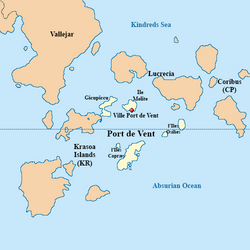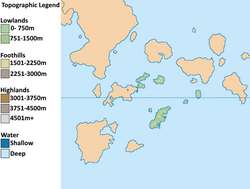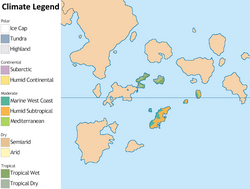Port de Vent: Difference between revisions
m (→Prehistory) Tag: 2017 source edit |
m (→Prehistory) Tag: 2017 source edit |
||
| Line 115: | Line 115: | ||
However, around 1100 BCE, Sundaic legends speak of encountering the "Sky People," beings of immense stature who arrived in colossal vessels and possessed advanced knowledge. These enigmatic figures, most likely the [[Glaistic_civilization#Tribes|Alitros tribes of the Glaistic civilization]] being pushed out of the islands of modern-day [[Lucrecia]] by the [[Glaistic_civilization#Tribes|Eudetos tribes]]. They built structures of massive stone blocks that defied explanation as the verbal histories of the . The Sundaic, initially wary, eventually formed a tentative connection. The Sky People may have shared some of their knowledge, influencing the island's intricate water channels and the unique architectural style of some Sundaic structures, incorporating megaliths. Port de Vent became an interface between ancient [[Loa]] and [[Glaistic civilization|Glaistic]] cultures. Evidence suggests that [[Glaistic_civilization#Glaistic_masks|Glaistic masks]], with their enigmatic smiles and intricate details, may have been incorporated into Sundaic rituals, later evolving into symbols of power and leadership. The Sundaic language began to borrow [[Glaistic civilization|Glaistic]] words and symbols, creating a unique dialect by 800 BCE. | However, around 1100 BCE, Sundaic legends speak of encountering the "Sky People," beings of immense stature who arrived in colossal vessels and possessed advanced knowledge. These enigmatic figures, most likely the [[Glaistic_civilization#Tribes|Alitros tribes of the Glaistic civilization]] being pushed out of the islands of modern-day [[Lucrecia]] by the [[Glaistic_civilization#Tribes|Eudetos tribes]]. They built structures of massive stone blocks that defied explanation as the verbal histories of the . The Sundaic, initially wary, eventually formed a tentative connection. The Sky People may have shared some of their knowledge, influencing the island's intricate water channels and the unique architectural style of some Sundaic structures, incorporating megaliths. Port de Vent became an interface between ancient [[Loa]] and [[Glaistic civilization|Glaistic]] cultures. Evidence suggests that [[Glaistic_civilization#Glaistic_masks|Glaistic masks]], with their enigmatic smiles and intricate details, may have been incorporated into Sundaic rituals, later evolving into symbols of power and leadership. The Sundaic language began to borrow [[Glaistic civilization|Glaistic]] words and symbols, creating a unique dialect by 800 BCE. | ||
Around 600 BCE, Sundaic legends speak of a devastating tsunami that impacted the [[Catenias]] archipelago. The [[Glaistic civilization|Glaistic]] outposts across the region, including those on Port de Vent, were abandoned or destroyed. The Sky People vanished from the Sundaic historical record. The Sundaic, grappling with the aftermath of the disaster, were left with fragmented ethnolinguistic and architectural artifacts. The Glaistic structures became overgrown with vegetation, not to be rediscovered for 2500 years. After the disaster, limited resources and populations, competition for fertile land, and fishing grounds grew between different Sundaic settlements, led to the rise of chiefdoms vying for dominance. Trade with neighboring regions remained limited as the Sundaic, focused on self-reliance and the preservation of their own traditions. | Around 600 BCE, Sundaic legends speak of a devastating tsunami that impacted the [[Catenias]] archipelago. The [[Glaistic civilization|Glaistic]] outposts across the region, including those on Port de Vent, were abandoned or destroyed. The Sky People vanished from the Sundaic historical record. The Sundaic, grappling with the aftermath of the disaster, were left with fragmented ethnolinguistic and architectural artifacts. The Glaistic structures became overgrown with vegetation, not to be rediscovered for 2500 years. After the disaster, limited resources and populations, competition for fertile land, and fishing grounds grew between different Sundaic settlements, led to the rise of chiefdoms vying for dominance. Trade with neighboring regions remained limited as the Sundaic, focused on self-reliance and the preservation of their own traditions. | ||
===Antiquity=== | |||
The northern islands of Port de Vent were conquered and ruled by the [[Lucrecia#Antiquity_and_the_first_Emeritan_state|''Emerita Maris'']] (modern-day [[Lucrecia]]), until the | |||
==Geography== | ==Geography== | ||
Revision as of 15:48, 20 May 2024
This article is a work-in-progress because it is incomplete and pending further input from an author. Note: The contents of this article are not considered canonical and may be inaccurate. Please comment on this article's talk page to share your input, comments and questions. |
Trade Islands of Port de Vent | |
|---|---|
 Map of Port de Vent | |
| Nation | |
| Constituent Country equivalent | Burgoignesc Overseas Representative Assembly |
| Geographic Designation | Polar Burgundies |
| Capital | Ville Port de Vent |
| Area | |
| • Total | 62,366.9137 km2 (24,080.0000 sq mi) |
| Population (2030) | |
| • Total | 11,302,230 |
| • Density | 180/km2 (470/sq mi) |
| Demonym(s) | Ventoise |
Port de Vent is an trade island province of Burgundie in the Kindreds Sea's Catenias archipelago, consisting of three major islands.
History
The islands of the Vallosunesoi Archipelago have long been a cultural cross roads. Archeological evidence suggests that the islands that make up Port de Vent have been permanently populated for almost 30,000 years, but have hosted transient populations as long as humans have been in southeastern Sarpedon and Vallos.
The native people were most closely related to proto-Vallejari.
Prehistory
Archeological evidence suggests that humans first settled permanently on the islands of modern Port de Vent around 4200 BCE. The Sundaic, a tribe of Loa sea people, established their first settlements along the coast, carving rudimentary dwellings into the cliffs. Their lives revolved around fishing, hunting, and navigating the treacherous currents of the archipelago's straits. Their culture featured tattooing, stilt houses, jade carving, wetland agriculture, and various rock art motifs. Their agricultural efforts and diet consisted of early domesticated plants and animals including rice, bananas, coconuts, breadfruit, Dioscorea yams, taro, paper mulberry, chickens,pigs, and dogs.
However, around 1100 BCE, Sundaic legends speak of encountering the "Sky People," beings of immense stature who arrived in colossal vessels and possessed advanced knowledge. These enigmatic figures, most likely the Alitros tribes of the Glaistic civilization being pushed out of the islands of modern-day Lucrecia by the Eudetos tribes. They built structures of massive stone blocks that defied explanation as the verbal histories of the . The Sundaic, initially wary, eventually formed a tentative connection. The Sky People may have shared some of their knowledge, influencing the island's intricate water channels and the unique architectural style of some Sundaic structures, incorporating megaliths. Port de Vent became an interface between ancient Loa and Glaistic cultures. Evidence suggests that Glaistic masks, with their enigmatic smiles and intricate details, may have been incorporated into Sundaic rituals, later evolving into symbols of power and leadership. The Sundaic language began to borrow Glaistic words and symbols, creating a unique dialect by 800 BCE. Around 600 BCE, Sundaic legends speak of a devastating tsunami that impacted the Catenias archipelago. The Glaistic outposts across the region, including those on Port de Vent, were abandoned or destroyed. The Sky People vanished from the Sundaic historical record. The Sundaic, grappling with the aftermath of the disaster, were left with fragmented ethnolinguistic and architectural artifacts. The Glaistic structures became overgrown with vegetation, not to be rediscovered for 2500 years. After the disaster, limited resources and populations, competition for fertile land, and fishing grounds grew between different Sundaic settlements, led to the rise of chiefdoms vying for dominance. Trade with neighboring regions remained limited as the Sundaic, focused on self-reliance and the preservation of their own traditions.
Antiquity
The northern islands of Port de Vent were conquered and ruled by the Emerita Maris (modern-day Lucrecia), until the
Geography

Climate and environment

Port de Vent has a tropical wet and dry climate.
- Geography_of_New_Caledonia#Climate (reference)
Economy
Standard of living
Employment
Agriculture
Agrinergie
Main article: Agrivoltaics
Tourism and hospitality
Resorts
Cruises
Recreation
Key tourism and hospitality companies
Logging/Mineral extraction
Paper milling
Mining
Drilling
Fishing
Fishing and fisheries
Distant-water fishing fleet
Local commercial fishing
Aquaculture
Main article: Aquaculture Aquatic life farming, in general
- Pisciculture- fish farming
- Mariculture- Saltwater fish farming
- shrimp farming
- oyster farming
- algaculture
Artisanal/heritage industries
Science and research
Finance
Manufacturing
Industrial recycling
Creative industries
Sports and leisure
Trade
| Port Nova Martillia | |
|---|---|
 | |
| Location | |
| Country | |
| Details | |
| Opened | 1949 |
| Employees | 550 |
| Statistics | |
| Vessel arrivals | 179 |
| Annual cargo tonnage | 805.219 tonnes |
| Annual revenue | ₮25 million |
Transshipment
Main article: Transshipment
Customs and tariffs
Main article: Customs
